What do you consider the quintessential American car?
It struck me when writing this review that answers to this question will vary by age. People under the age of 40 might have no answer at all. As far back as their memory of cars goes Detroit has been trying to find itself. Those over 50, though, will remember when THE American car was an affordable large sedan with a V8 powering the rear wheels.
Today no such car is being manufactured in the United States. Instead, even if we liberally draw the line at $50,000, we have only the Dodge Charger / Chrysler 300 sibs from Canada and the Chevrolet SS from Australia. Are these cars anachronisms that no longer make sense in the current context? Do they deserve their niche status? Or does the formula for the quintessential American car remain a compelling one that many people would enjoy, if only they thought to consider it?
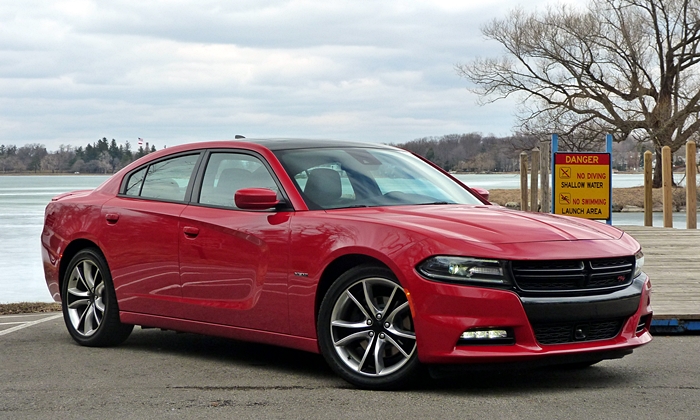
Nothing too wild, but appropriately sinister stance and detailing. R&T-specific wheels a good fit. more Charger photos
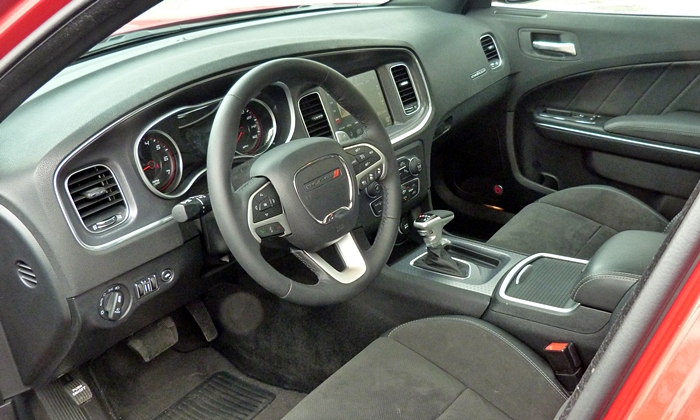
Subtly retro interior, with attractive aluminum and suede trim.
| |
Compared to the SS |
| Price or payments |
 Better
Worse
Better
Worse
|
Back in the day, Detroit sold extra cylinders cheap. With the 1995 Chevrolet Caprice, it cost only $550 to upgrade from a 200-horsepower V6 to a 260-horsepower V8. Even the tricked-out Impala SS could be purchased for $23,495--less than a contemporaneous Honda Accord EX-L V6.
Those days are gone.
A 2015 Honda Accord EX-L V6 lists for $31,315. You can't buy a V8 sedan from anyone for that price. But, with a base price of $34,590, the Dodge Charger R/T comes closest. Add the $3,000 Road & Track Package to upgrade the steering, suspension, brakes, headlights (to xenon), and seats (more on these later), and the Charger still undercuts the next-least-expensive V8-powered sedan, the $39,065 Chrysler 300S. When both are similarly loaded up, the Chrysler costs about $3,700 more than the Dodge.
And Chevrolet's current SS sedan? It checks in $10,000 above the R/T Road & Track, at $48,040. Granted, Chevrolet has opted to only offer the SS with everything save a $900 sunroof standard. But similarly load up a Charger R/T Road & Track and the tab still comes to just $41,570, over $7,000 less than the Chevrolet.
The SS also has 45 more horsepower than the Charger R/T, 415 vs. 370. If this is a concern, the Charger is offered with two other V8s, a 485-horsepower 6.4-liter and a 707-horsepower supercharged 6.2-liter. With the former, the Charger R/T Scat Pack still lists for nearly $1,000 less than the SS when similarly equipped.
The Charger Hellcat is a different story. If you want the world's most powerful production sedan, it'll cost you $64,990--if you can find a dealer who can get one for you, and who is willing to sell it for MSRP. Compared to other 600-plus-horsepower sedans, it's a bargain.
Korea offers a couple of V8 sedans that, while much less expensive than the Japanese and European models they target, still start over $50,000.
Despite the rage currently surrounding the Hellcat, I opted to test the redundantly appelated R/T Road & Track because it puts a V8-powered sedan with a sport suspension and sport seats within reach of the most people. Among V8-powered sedans, it's the clear value champ.
| Powertrain performance |
 Better
Worse
Better
Worse
|
A stock Dodge Charger can be propelled by as much as 707 horsepower. But the supercharged Hellcat, like other V8-powered Chargers this year, is only offered with rear-wheel drive. Two tires, even two wide sticky ones, cannot transfer this much power to the pavement below 40 mph. Opening up the throttle in first gear with traction control deactivated transforms solid rubber into a black cloud.
If your driving will be limited to public roads, the Charger R/T Scat Pack's 485-horsepower V8 can deliver all the thrust you can use at legal speeds, and then some. Drop down another level, to the tested 370-horsepower R/T Road & Track, and the Charger can still get from a dead stop to 60 mph in well under six seconds. It might be about a second behind the Scat Pack and two seconds behind the Hellcat, but the regular R/T is nevertheless a very quick car. Even Dodge's weakest V8 delivers the sort of low-rpm punch at which Detroit traditionally excelled. For a strong, clean departure from the line every time, launch control is included in the Road & Track package.
Acceleration times for the lighter, rawer-sounding (with an intoxicating snap-crackle-pop when you lift) Chevrolet SS split the difference between those for the regular R/T and the R/T Scat Pack.
When I reviewed the Charger three years ago, I recommended the V6 over the V8--but not primarily because of differences between the engines. The 300-horsepower 3.6-liter V6 motivates two tons of Charger well enough, but cannot approach the low-rpm thrust of the much larger V8s. But the 2012-2014 V6 was paired with a responsive state-of-the-art eight-speed automatic transmission, while the V8s continued to be hobbled by a sluggish, antiquated slushbox with only five widely spaced ratios. I preferred the V6 powertrain's more immediate responses to the V8 powertrain's brute force.
With the 2015 update, you no longer have to choose between power and responsiveness, as the V8 engines are now paired with the eight-speed automatic. Even better, the monostatic shifter employed with this transmission from 2012 through 2014 has been ditched in favor of one that, while still electronic, convincingly mimics a conventional mechanical shifter, taking the guesswork out of finding reverse.
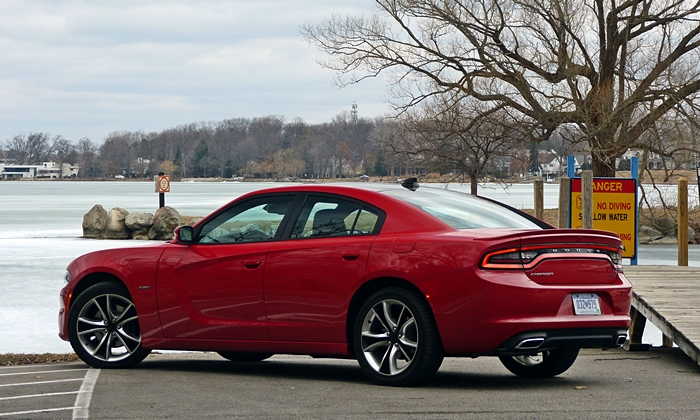
The Charger appears a bit bulky through the rear body. Racetrack LED tail light a nice detail.
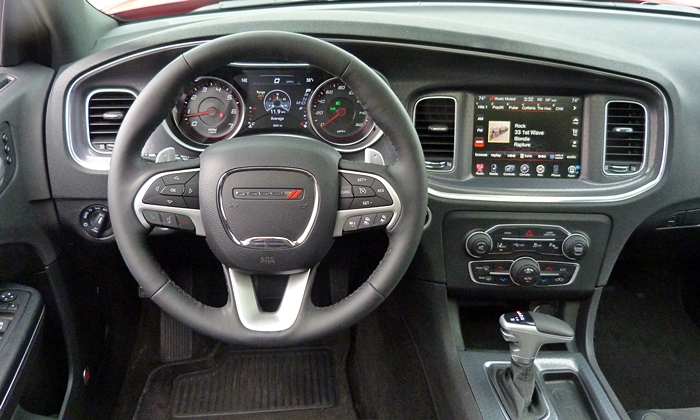
Despite the car's many features, perhaps the most user-friendly instrument panel I've found.
| Ride smoothness |
 Better
Worse
Better
Worse
|
We don't really have a category for my favorite thing about the Charger. I'm not even sure what I'd call such a category, Making do, I've selected "ride smoothness."
But I'm not talking about a pillowy, insulated ride. The Dodge Charger R/T Road & Track's suspension is firm, if thoroughly livable and never harsh. Instead, what impresses most about the Charger is how it feels going down the road: solid, poised, commanding, simply right. Though I personally favor compact cars for their agility, I couldn't help but deeply enjoy my time helming the Charger. There's something here that even large front-wheel drive sedans can't seem to provide.
Perhaps because it's about 300 pounds lighter slightly more compact, and positions the driver higher above the instrument panel, the Chevrolet SS doesn't deliver the same king-of-the-road vibe. Yet in some ways the SS manages to ride better, with good bump absorption even in "performance" mode and no sense from the driver seat that the tires and wheels constitute more unsprung mass than the suspension can transparently manage. (You sense the weight of the Dodge's dubs a bit.) Much credit might be due the adaptive dampers added for 2015. To get similar equipment on the Dodge you must step up to the SRT.
Then there's noise. Especially at highway speeds on coarse pavement, much more road noise and a little more exhaust drone intrudes into the Chevrolet's interior. If you want a relaxing highway cruiser, the Dodge is the clear winner.
| Front seat support & comfort |
 Better
Worse
Better
Worse
|
The Road & Track package includes some of the best front seats I've experienced. The side bolsters, though not adjustable, manage to effectively hold slender drivers in place without uncomfortably constraining far-from-slender ones. Synthetic suede center panels assist in this task. Yet as performance-oriented as these seats are, they aren't overly firm, and should prove comfortable even on day-long drives.
Despite the more hardcore nature of the Chevrolet SS, its front seats have much smaller, far less effective bolsters. Some synthetic suede helps to mitigate this shortcoming, but the Dodge's buckets are much better for both comfort and support.
| Controls and instruments |
 Better
Worse
Better
Worse
|
Everyone is experimenting with high-tech interfaces. So far, only Chrysler has delivered one that can be operated on the fly with minimal attention. The secret: large, well-spaced virtual buttons on a large, well-located touchscreen.
Some companies would have used this achievement to justify eliminating physical controls. Chrysler instead supplements the touchscreen with large, well-designed physical knobs and buttons. Want to channel-surf the old-fashioned way? There's a big knob for that, twirl away.
The Chevrolet's infotainment controls also include a couple of knobs, but the right one does different things depending on which screen you are on. In general I found these controls much less intuitive, if far from the worst.
| |
Compared to the SS |
| Feature availability |
 Better
Worse
Better
Worse
|
You can get just about any feature offered on any $40,000 car on the Charger, including full-speed adaptive cruise control, forward collision warning, lane departure warning, blind spot warning, auto-dimming xenon headlights, rain-sensing wipers, heated-and-cooled 12-way-power front seats, heated folding rear seats, and a heated power-tilt-and-telescoping steering wheel. Plus a 552-watt Beats audio system.
What has Chrysler withheld for the closely related but more expensive 300? Not much aside from the options of more extensive leather upholstery, real wood trim, and a panoramic rather than a conventional sunroof. While I prefer the styling and additional luxury of the 300, I don't think I'd pay the higher price for it.
Yet we find feature availability among the "why nots." The reason: powertrain options. Sure, you can get a V6 or any of three different V8s. But, unlike in previous years, all-wheel drive is offered only with the V6. This will limit the Charger's appeal in locales with distinct seasons.
Many driving enthusiasts won't mind this nearly as much as they'll mind the lack of transmission options. Unlike with the related two-door Dodge Challenger and the Chevrolet SS, a manual isn't offered.
Of course, if you want a rear-wheel-drive sedan with an automatic transmission, then ignore this "why not."
| Rear seat room & comfort |
 Better
Worse
Better
Worse
|
The Dodge Charger's rear seat cushion is comfortably shaped and positioned. Rear knee room, though less abundant than the sedan's exterior dimensions might suggest, is neverless generous. So what is rear seat room doing among the reasons not to buy a Charger?
Well, headroom is in short supply. People 5-11 and up could become painfully familiar with the backlight. Shorter passengers won't experience this issue, but could find the back seat uncomfortably confining because the smallish rear side windows descend only to neck level. For more rear headroom and larger rear side windows, check out the related Chrysler 300. Or the Chevrolet SS, which has 1.4 inches more rear headroom than the Charger.
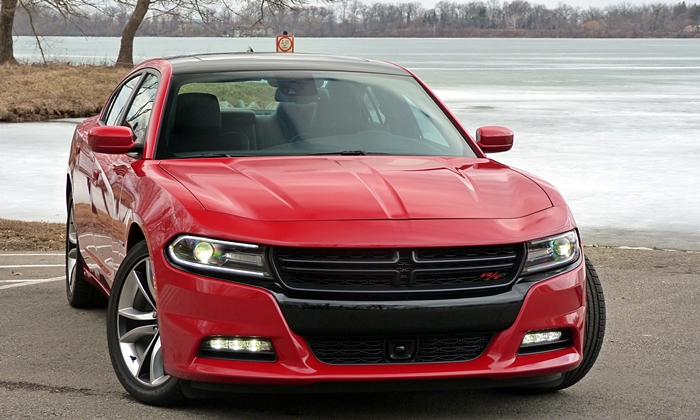
Thoughts on the new face of Dodge? Black roof adds $1,500.
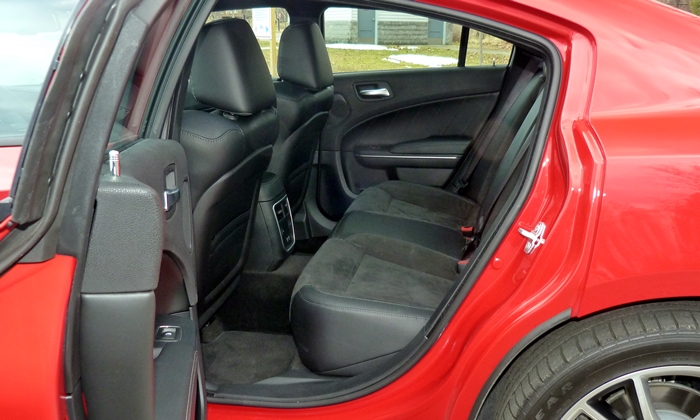
Comfortably shaped and positioned rear seat, but limited head room and small windows.
| Materials & workmanship |
 Better
Worse
Better
Worse
|
I don't really want to list interior materials among the reasons not to buy a Dodge Charger. Compared to other cars with prices under $40,000, or to the nearly $50,000 Chevrolet SS, the Charger's materials are competitive. The soft leather and suede on the seats is more than competitive, and the "hectic mesh" aluminum trim on the dash and console is a clear step up from the plastic in the SS.
But if you want the sort of interior found in more expensive V8-powered sedans, you're going to have to pony up for at least the $52,450 Hyundai Genesis 5.0.
| |
Compared to the SS |
| Exterior styling |
 Better
Worse
Better
Worse
|
Overall, I like the exterior of the Dodge Charger, but feel they could have done a better job of it. The rear quarters in particular appear bulky and somehow unfinished. The new face, designed to mimic that of the much smaller Dart, doesn't make much of a statement.
This said, the Charger's exterior is high art compared to that of the Chevrolet SS. The SS's basic shape, essentially a super-sized circa-2000 BMW 3 Series, is handsome enough. But the clean lines that worked for the Pontiac G8 wouldn't do for a Chevrolet. GM felt the need to tack on a bunch of chrome trim and a horizontally split grille, neither of which fit the design or the character of the car. If only the SS were as attractive as the similarly dimensioned but front-wheel-drive Impala...
| Handling |
 Better
Worse
Better
Worse
|
I've already noted how much I enjoyed driving the Dodge Charger. Suspension tweaks for 2015 better counteract the V8 engine's 300 additional pounds over the front axle, improving both balance and agility. The Charger R/T still feels large and heavy, but not unwieldy. It responds readily and intuitively to steering inputs. The steering, though electrically assisted in all but the Hellcat, feels naturally weighted and delivers some feedback. In sport mode it firms up a bit more.
As with any well-tuned rear-wheel drive car, you can also employ the throttle to nudge the Charger's rear end around. The handling of a powerful rear-wheel-drive car can get really scary really fast, but not in this case (unless you turn the stability control completely off then get crazy with the wheel and pedals). The axes of rotation and roll seem to be located right where they ought to be, which lends the handling a natural, intuitive character. You can feel rather than consciously think your way through curves.
Electronics lend a hand. An expertly tuned stability control system keeps oversteer within safe limits without seeming overly intrusive. The Road & Track package includes a sport mode for the stability control. In this mode, the system intervenes at a higher threshhold to permit more throttle-induced oversteer. Like the best stability control systems, it makes you feel like a better driver.
Still, the improvements to the Charger's chassis for 2015 are only enough to keep handling out of the "why nots." The Chevrolet SS handles better still. Partly because the Chevy from down under weighs 300 pounds less and rides on a wheelbase five inches shorter than the Chargers, it feels significantly lighter, more agile, more precise, and even more intuitive. Especially during aggressive cornering the SS's steering feels tighter and delivers more nuanced feedback. As much as I enjoy tossing the Charger about, it's not a precision instrument that asks to be guided with your fingertips. The SS is and does. Opt for a manual transmission in the Chevrolet, and you'll feel even more directly connected to the car.
| Fuel economy |
 Better
Worse
Better
Worse
|
Anyone with much interest in fuel economy isn't going to buy a Charger. Or, if they do buy a Charger, it will be the V6, with EPA ratings of 19 mpg city and 31 mpg highway (the latter impressive for a two-ton 300-horsepower car).
But you also don't see fuel economy among the "why nots" for the Dodge Charger R/T. It might only rate 16 mpg city and 25 mpg highway, but these figures are better than the Chevrolet SS's dismal 14/21 and the Hyundai Genesis 5.0's 15/23. Among semi-affordable V8-powered sedans, the Charger is the fuel economy champ.
One trick: even at highway speeds the V8 cruises on half its cylinders. The transition between V4 and V8 modes is quick and virtually imperceptible, a "four-cylinder" light between the tach and speedometer the only clear indication. Keep the engine in four-cylinder mode nearly the entire time and the trip computer will report an average around 30 mpg, while the SS will struggle to crack 24. However, if you catch many red lights then realize much of the V8's potential when they turn green, then the average rapidly plummets into the teens, even the low teens--little if any better than the SS in the same scenario. Even idling takes a significant toll, as the Hemi hasn't yet been fitted with an auto start / stop system. Over the course of a week I averaged a bit over 18 mpg.
Subjected to a point-by-point analysis, the Dodge Charger has some clear strengths, but doesn't seem all that compelling. Something like a Honda Accord makes far more rational sense.
But drive the Charger and it reminds even a smaller-and-lighter-is-better proponent like myself why Americans used to love large, powerful, rear-wheel-drive sedans. Especially with the 2015's updated powertrain and suspension, the Charger feels so poised and confident, so right.
The Chevrolet SS handles with more agility and precision, but has a different character (which some might prefer), doesn't look as good, and costs more. Load a Charger up with everything save the tested car's red paint ($500) and black roof ($1,500), and the sticker price remains in the low 40s. Drop the $2,090 Technology Package (adaptive cruise control, electronic safety aids), and the sticker falls to just over $40,000. This is a tremendous amount of car for $40,000. And that's the sticker price. The actual price after discounts and incentives could be $5,000 lower.
So why doesn't Dodge sell more of them? Probably because few people shopping for a sedan bother to test drive a Charger. More people should, while they still can.
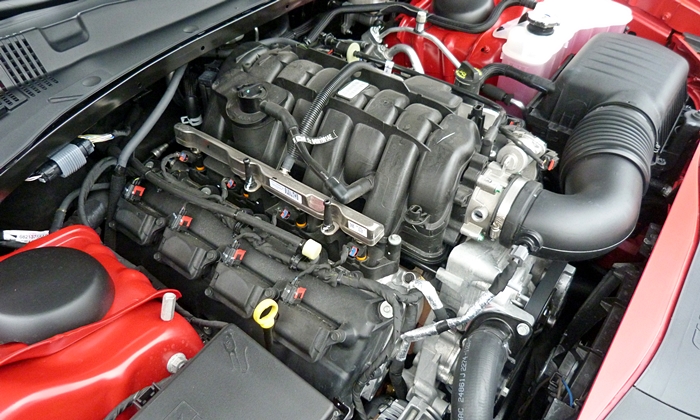
The 370-horsepower V8 engine is much more exciting to look at than its plastic cover (removed here).
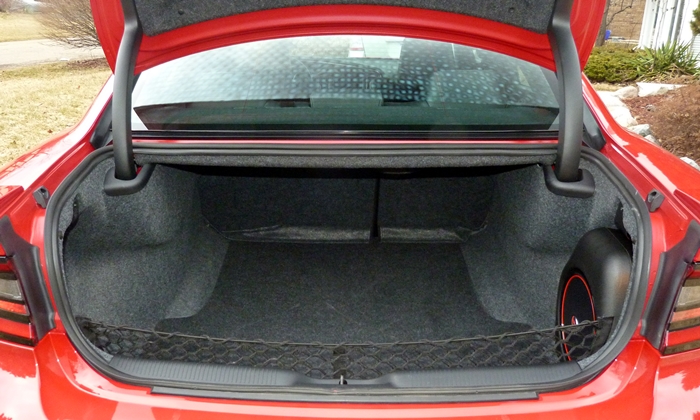
As in the SS, about 16 cubic feet of trunk space. About as much as in a midsize FWD sedan.
See more 2015 Dodge Charger photos
Dodge and Chevrolet each provided an insured car for a week with a tank of gas.











